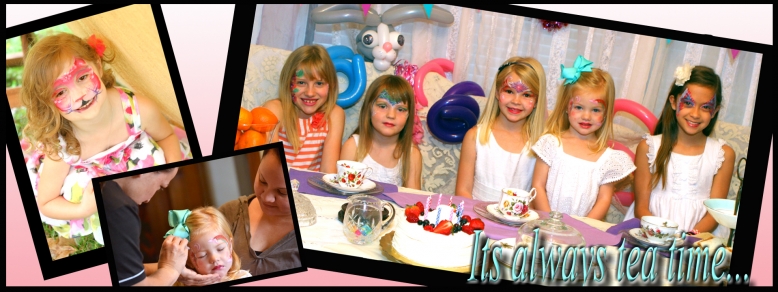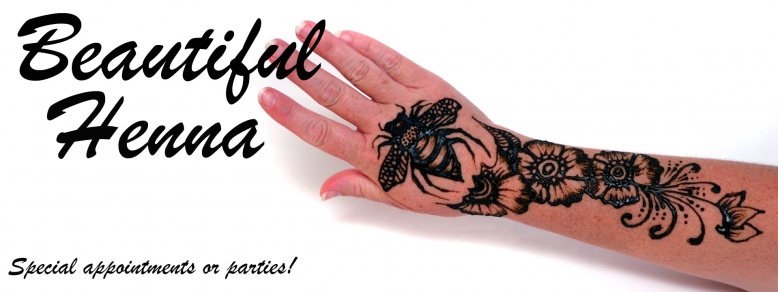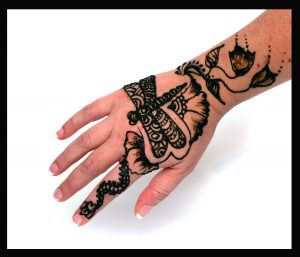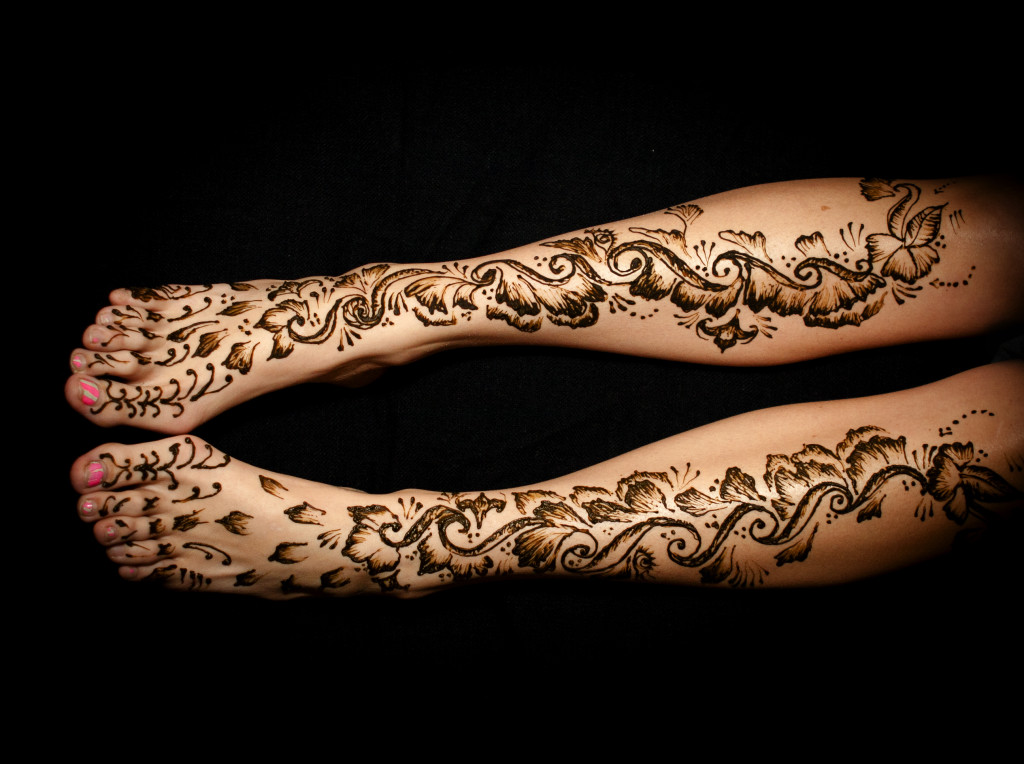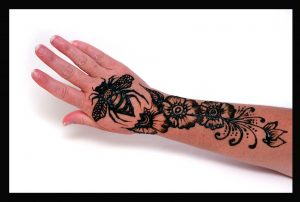Henna (Mehndi) Art
Offering Henna Parties, private appointments in our home studio or bridal henna, Wagner Events can take care of all of your Henna and Mehndi needs! Henna is another name for the Lawsonia Inermis plant grown in arid areas of countries like Pakistan, India, and UAE to name a few. The leaves of this plant are dried, ground into a powder, then reconstituted to make a paste. Recipes to do this vary. The paste is applied to the skin in beautiful patterns to create a stain that can last anywhere from 4 days to 8 weeks depending on the person, how well it’s taken care of and the part of the body the paste is applied to.
Henna celebration – $150.00 (1 hr)
Beautiful and custom henna creations for 12-18 guests by Ms. Lorrin.
Special Henna Appointment (in our home studio) – $40.00 for each design (1 arm, 1/4 leg, 1/4 back)
We can accommodate a large number of guests in our home studio where you can get your henna prior to the big night out or as a special treat, call to schedule an appointment now! – 813-381-6586, weekday, weekend and custom times available at our home studio in Plant City.
Great Henna Stain in 4 Easy Steps!
Folklore says that the darker the stain, the more the bride’s mother in law will love her. No wonder bride’s strive for the darkest henna possible! Without fresh henna, a good color is impossible.
Luckily, the main ingredients are fresh henna and a large dose of patience.
Step one: the mehndi is applied to clean skin that is free of any oils or lotions. Lorrin uses an organically cultivated henna from Rajasthan and mixes it with Lemon Juice, sugar, and pure essential oils of Cajeput, Lavender and Cardamom.
Step 2: Once dry, the mehndi is sealed with a sugar solution. The stickiness of the sugar keeps it, well, stuck to you. The longer it remains in place, the better. A minimum of 6-8 hours is recommended. Traditionally henna is left on overnight. You can gently wrap your mehndi in tissue to keep it in place. Avoid cling-wrap, which can cause sweating and distortion of the design. A sock also works well.
Step 3: After 6-8 hours (or overnight), gently pick off the henna paste, or rub it off with a paper towel and oil (coconut is amazing!). Never wash it off or you will ruin the stain. It should be a bright orange color when you pick it off. Avoid water for an additional 12-24 hours. If this is not possible, generously oil your design with coconut oil, shea butter, or any other greasy vegetable-based oil.
Step 4: Continue to avoid water. You will see your design start to darken as it oxidizes throughout the day. Natural henna requires about 24 – 48 hours to reach its darkest point. The stain will always be darkest on the palms, where the thicker skin can absorb more henna, and lighter toward the thin skin of the wrists and arms for a beautiful ombré effect.
FREQUENTLY ASKED QUESTIONS
Feel free to email me if you would like to know more in-depth answers to the following questions:
Is it sacrilegious for me to use henna if I’m not East Indian or Muslim?
Short answer is no. Henna is not ‘sacred’ nor is it holy or blessed by any priest. The best analogy would be it is much like a wedding dress or wedding jewelry, considered a necessary tradition, and would be almost unthinkable to get married without it, but not a holy article. It is, however, considered to be lucky or auspicious and looked upon with favor by God/ the Gods in some cultures, and it is thought to ward off the evil eye in other societies. It is often gifted to a new bride or to someone having a celebration, a very welcome presentation. It is considered extremely beautiful and we all want to be stunning on our big day. It is said that the darker your henna stains, the more your husband or mother-in-law loves you. (depends on where you are if it’s mother-in-law or husband). The traditions of henna are anywhere from 5000 to 9000 years old, 60 countries and 6 major religions so it ‘belongs’ to no one group in particular and the folklore behind it is varied. Henna has been and still is practiced in many different cultures including Jewish, Christian, Muslim and Hindu. All it takes to have henna is the desire to be individual and beautiful. Because it’s considered lucky people will wear it before a test or when they are going to try something that they want to turn out successfully.
OK, so WHAT is in henna?
Henna is another name for the Lawsonia Inermis plant grown in arid areas of countries like Pakistan, India, and UAE to name a few. Henna is also the term used for the action. “I’m getting a henna” or “I’m going to do some henna today”. The leaves of this plant are dried, ground into a powder, then reconstituted to make a paste. Recipes to do this vary. My paste includes sugar, henna, lavender, cajuput and Eucalyptus essential oils and lemon juice. The paste is applied to the skin in beautiful patterns to create a stain that can last anywhere from 4 days to 8 weeks depending on the person, how well it’s taken care of and the part of the body the paste is applied to. It has many names as well, mehndi, mehandi, henna, hina, heena are some of the variations all meaning the same thing. Henna also has medicinal uses in controlling foot issues, parasitic pests and is a natural sunscreen. It was used frequently in many cultures for these properties.
Is henna safe?
Real henna is safe for almost everyone. Unfortunately there are people who are practicing the art in pop up tents, salons, festivals and street corners who are using questionable ingredients or ‘black henna’ which is a chemical and illegal in the US. Often this contains no henna whatsoever. Pure henna is probably one of the world’s safest and oldest cosmetics. In America right now there is no licensing, insurance or criminal background check of street / festival artists / Hair and beauty salons when it comes to the application of henna and no one inspects the products used so it’s up to you to be the smart consumer.
If you are allergic to perfumes, you should talk to your artist before getting henna done, as some individuals may be sensitive to lavender or other added oils. You should always ask what is in the mix and if they cannot or will not tell you, claim it is their heritage or make you feel foolish for asking, you should consider avoiding that vendor. It’s your body and you have every right to ask questions before letting someone embellish it with anything.
If your doctor has ever told you that you have G6PD or you are allergic to fava beans and asperin, you should not be using henna. Children under 5 should also avoid henna.
So, how do I get colored henna?
The short answer is, you don’t. The colored designs seen on this site are henna embellished with zardosi (body safe glitter and gold), real Swarovski crystals and body safe skin paints or temporary tattoo ink. This technique is usually used on a bride one or 2 days after paste removal to make her designs even more beautiful for the big day. The patterns that appear black are designs that still have the henna paste on. It does NOT come in colors. If it is black or colored it is NOT henna. The PPD black is banned by USDA but rampant in USA, Mexico & Greece. Most so called ‘colored henna’ is going to lighten your wallet and not stain at all, at best, hurt you at worst. Don’t be taken advantage of!
I forgot I had a big meeting/photoshoot/granny hates henna! Can I take it off quick?
Henna stains don’t really wash off quickly. Once you have it, it has to fade. That being said, there are ways to help it along if you have to.
This is easier if you are somewhat older as the skin starts to thin and therefore you have less layers to exfoliate through. You can try a whitening toothpaste or a soak in a hot tub or a swim in a public pool. Chlorine and henna do not get along and the chemicals will help expedite the demise of the stain as well. Doing a lot of housework with cleaning products has been shown to be the enemy of the mehndi stain.
I heard there are medical benefits to henna…is that true? What are they?
Henna has been used for centuries for its many unusual properties as well as discovering new ones! Digestion is NEVER recommended, but for foot ailments it can do wonders! Recently it has been proven very helpful for those suffering from Xeloda side effects tip for Hand-Foot Syndrome (HFS or PPE) in chemotherapy patients. Henna has also been used to deter foot fungus and lice and is a natural sunscreen.
I got one! I love it! Now how do I take care of it?
As much heat as possible for the first 24 hours even after paste is removed.
Hair dryers work well, steam works best but please use utmost caution when steaming. Steam can cause serious burns if you’re not careful. Even when the henna paste is removed, exposure to regular heat will help it to darken.
Henna is rarely dark on the upper arm or shin. Darkest colors will be on the toes, fingers and palm.
– Do not wash with water. No water contact for 24 hours if possible (48 hours is even better) Pick or scrape paste off after 8 hours. If paste falls off earlier, don’t panic. It’s done its job. Just don’t help it along by picking.
– Leave paste on for a minimum of 4 hours. Overnight makes for the best results.
-Design will progress from orange tones to burgundies or browns depending on the person in about 48 hours. Color may continue to deepen even longer on some individuals so do not panic when the paste falls off and it is only faint orange. It will get darker with time.
– No exfoliates (chlorine, most hand lotions) No pools or hot tubs. No antioxidants such as found in many face lotions and hand lotions.
-to slow design from fading, protect during water contact by using natural oils, such as olive or corn. A latex glove with an elastic band at the wrist is helpful to protect hand mehndi when showering. Some wax based balms are also helpful to make water bead away from the design. No wax balms with exfoliating properties or anti-oxidants should be used.
-When tanning, please keep in mind that areas recently hennaed are ‘sun screened’ and will not tan. A ‘ghosting’ effect may occur where un-hennaed skin will tan and the pattern will not.


